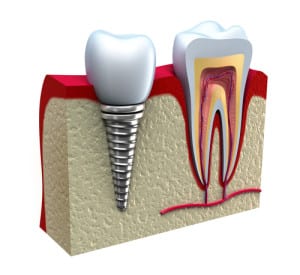 If you’re missing teeth, chances are you’ve looked (or are looking) into your restoration options. Ah, the great debate – what would work best for you? A visit to your dentist will get you started with determining how extensive the damage to your mouth is and how you can begin the restoration process. How do dental implants work? These “new teeth” are installed directly into your gums all the way to your bone – which is it’s required that you have a good amount of bone density in order to qualify for this restoration option.
If you’re missing teeth, chances are you’ve looked (or are looking) into your restoration options. Ah, the great debate – what would work best for you? A visit to your dentist will get you started with determining how extensive the damage to your mouth is and how you can begin the restoration process. How do dental implants work? These “new teeth” are installed directly into your gums all the way to your bone – which is it’s required that you have a good amount of bone density in order to qualify for this restoration option.
How They Work
Once they’re installed into your gums, it takes about three to six months before they are completely fused with your bone. During this time, they are working on directly attaching to your bone so they won’t ever fall out. When patients don’t qualify for dental implants, it’s typically because they don’t have enough bone density to be able to secure the new tooth permanently.
After they’ve completely fused with your bone, you’re good to go. These implants act as a replacement for your tooth, essentially giving you an entire new tooth (or teeth depending on your situation) that is cosmetically appealing and fully functioning for everyday tasks.
In fact, dental implants have an extensive list of benefits that doesn’t stop at their permanency and aesthetic appeal – they cannot be harmed from bacteria, plaque, tartar, or debris. They even serve as a sort of protection for your other teeth, gum tissue, and bone because they cannot become infected.
